Spot-breasted Oriole
A species of New world orioles Scientific name : Icterus pectoralis Genus : New world orioles
Spot-breasted Oriole, A species of New world orioles
Botanical name: Icterus pectoralis
Genus: New world orioles
Content
Description General Info
Description
The spot-breasted oriole (Icterus pectoralis) is a species of bird in the family Icteridae. It is a mid-sized songbird and generally typical oriole. It is bright orange overall with a black bib and black spotting on the sides of the breast. The sexes are similar looking generally but females and juveniles are olive-green on the back and tail, dusky wings, and little or no black on face, throat, or breast. Adults measure 21–24 cm (8.3–9.4 in) in length. Males weigh around 50 g (1.8 oz) on average, while females weigh 45 g (1.6 oz). The wing bone measures 8.8–11.4 cm (3.5–4.5 in), the tail measures 8.5–11.2 cm (3.3–4.4 in), the culmen measures 1.9–2.4 cm (0.75–0.94 in) and the tarsus measures 2.6–3 cm (1.0–1.2 in). It is native to Costa Rica, El Salvador, Guatemala, Honduras, Mexico, and Nicaragua. Its natural habitats are subtropical or tropical dry forests, subtropical or tropical moist lowland forests, and heavily degraded former forest. The spot-breasted oriole ranges only on the Pacific side of Central America. An introduced breeding population also exists on the Atlantic coast of southern Florida. The population is considered to be established enough to be "countable" for birdwatchers by the ABA. 
Size
21-24 cm (8.25-9.5 in)
Life Expectancy
12 years
Nest Placement
Tree
Feeding Habits
Spot-breasted Oriole consumes a varied diet of insects, berries, and nectar, showcasing an omnivorous feeding behavior that includes both plant and animal matter.
Habitat
Spot-breasted Oriole typically thrives in a variety of environments; its habitat includes suburban areas with tall trees, offering numerous nesting sites. Indigenous to open woodlands, spot-breasted Oriole favors landscapes that are characterized by dry scrub and forest edges. It is also frequently spotted in agricultural surroundings, such as ranches and villages. Spot-breasted Oriole readily adapts to human-altered habitats, which align with its preference for lower altitudes and warm, temperate climates.
Nest Behavior
Nesting occurs as spot-breasted Oriole meticulously weaves its nest where both parents partake in caring for the eggs and young, although specific patterns in timing and egg-laying can vary.
Nest Characteristics
The nest of spot-breasted Oriole is a long, hanging pouch crafted from fibers and thin roots of epiphytes, typically suspended in a tree branch fork.
Dite type
Frugivorous
General Info
Feeding Habits
Bird food type

Fruit
Bird Feeder Type

Platform
Sounds
Song
Recording location: Mexico
Behavior
Spot-breasted Oriole exhibit a lively demeanor, primarily feeding by gleaning insects from foliage, skillfully unfurling rolled leaves to extract hidden prey, and frequenting flowers, likely for nectar or insect pollinators. They are diurnal, with activities centered on foraging, social interactions, and territory defense. These birds intricately engage with their habitat, utilizing the environment's resources to sustain their energetic lifestyle. Spot-breasted Oriole's distinctive foraging technique, involving the meticulous investigation of plant structures, underscores their specialized behavior within their ecosystem.
Species Status
Not globally threatened.
Scientific Classification
Phylum
Chordates Class
Birds Order
Perching birds Genus
New world orioles Species
Spot-breasted Oriole 